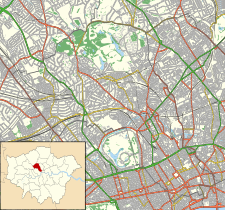Highgate Hospital
| Highgate Hospital | |
|---|---|
 Highgate Wing (on the right) | |
| Geography | |
| Location | Dartmouth Park Hill, Highgate, London. |
| Coordinates | 51°34′00″N 0°08′32″W / 51.56674°N 0.14234°W |
| Organisation | |
| Care system | National Health Service |
| Type | General |
| History | |
| Opened | 1869 |
| Closed | 1948 |
Highgate Hospital was a name used to refer to the infirmary building which opened in 1869 on the St Pancras side of Dartmouth Park Hill in Highgate, London.
History
The facility has its origins in the St Pancras Union Infirmary, which was designed by Giles and Biven and opened in 1866.[1][2]
Florence Nightingale advised the architects on the design of the building and later commented that it was "by far the best of any workhouse infirmary we have"[3] and indeed “the finest metropolitan hospital”.[4]
In 1869, Central London Sick Asylum District was altered to include St Pancras and the infirmary became known as Central London Sick Asylum.[5] This arrangement continued until 1893, when it reverted to the Guardians of the Poor as St Pancras North Infirmary, while the St Pancras Union Workhouse on King's Way (now St Pancras Way) became St Pancras South Infirmary.[6] Edith Cavell served as night superintendent from 1901 to 1904, when she was the only trained nurse on duty.[1]
The hospital was taken over by the London County Council in 1930 and renamed Highgate Hospital.[1] It became the Highgate Wing of the Whittington Hospital on the establishment of the NHS in 1948.[1][7]
Latterly a psychiatric hospital, in 2004, the Highgate Wing was chosen by Camden and Islington Community NHS Trust as the site for Highgate Mental Health Centre and the consolidation and development of community mental health and adult social care services.[8]
Notable staff
- Ellen Jean Moir (1847–1925),[9] Matron of St Pancras Infirmary from 1883 until 1910.[10][11][12] Previously Moir had worked at the Royal Infirmary Edinburgh, as a Private Nurse of The Westminster Hospital, and Night Sister at the Royal London Hospital, Whitechapel under Eva Luckes.[13] Luckes recommended Moir for the position at St Pancras Infirmary.[10] Moir was a member of the Workhouse Infirmary Nursing Association.[14] Edith Cavell was Night Superintendent here under Moir, for two years between 1901 and 1903.[10]
See also
References
- ^ a b c d "Highgate Hospital". Lost Hospitals of London. Retrieved 27 October 2016.
- ^ "St Pancras". Workhouses. Retrieved 22 February 2020.
- ^ McDonald, Lynn (2004). Florence Nightingale on Public Health Care: Collected Works of Florence Nightingale. Vol. 6. Wilfrid Laurier University Press. p. 447. ISBN 978-0889204461.
- ^ "Firing squads, hammers and spies: Trust's Tales". Camden & Islington News. 2014. p. 8.
- ^ Central London Sick Asylum District London Metropolitan Archives (retrieved 8 June 2022)
- ^ St Pancras Board of Guardians London Metropolitan Archives (retrieved 8 June 2022)
- ^ "Highgate Hospital, London". Lost Hospitals of London. Retrieved 22 February 2020.
- ^ Foot, Tom (17 March 2011). "Lost souls beyond a plush entrance to Highgate Mental Health Centre". Camden New Journal. Retrieved 2 July 2018.
- ^ "Death Of Miss Moir". Nursing Times. 21 (1051): 587. 20 June 1925 – via www.rcn.org.uk.
- ^ a b c Rogers, Sarah (2022). 'A Maker of Matrons'? A study of Eva Lückes's influence on a generation of nurse leaders:1880–1919' (Unpublished PhD thesis, University of Huddersfield, April 2022)
- ^ Matron’s Annual Letter to Nurses, No.17, Matron's Annual Letter to Nurses, 1894–1916; RLHLH/N/7/2, No.17, March 1910, 32
- ^ "Resignation of Miss Moir". Nursing Times. 6 (280): 355. 10 September 1910 – via www.rcn.org.uk.
- ^ Ellen Jean Moir, Register of Sisters and Nurses; RLHLH/N/4/1, 41; Barts Health NHS Trust Archives and Museums, London
- ^ "Workhouse Infirmary Nursing Association". The British Journal of Nursing. 30: 75–6. 24 January 1903 – via www.rcn.org.uk.
